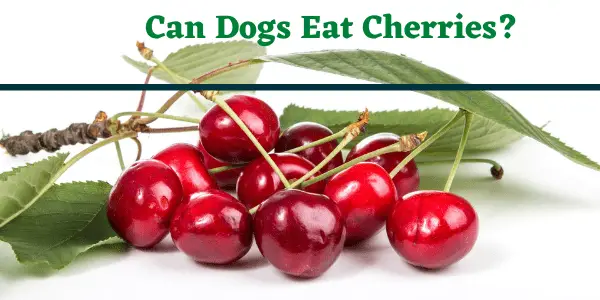Is eating cherries healthy for dogs? Cherries are most popular as a delicious filling for desserts or as a finishing touch to cakes and ice cream, but these fruits are also great when eaten fresh alone. “If only animals could talk, I’m sure they would love to ask,” Can dogs eat cherries too?”
Unfortunately, cherries are also among the unhealthiest foods our dogs can consume. True, these sweet summer fruits can provide dogs with useful vitamins and minerals, but they can do more harm than good. In this article, we will explain what you can do about the dangers of cherries if you intend to feed them to your dog.
Some links in this post are Amazon affiliates. We may earn a commission if you use these links to make a purchase.

Table of Contents
4 Reasons Why Dogs Can’t Have Cherries
Although red juicy cherry meat is rich in antioxidants, cherries still pose a health threat to our dog companions like a double-edged sword.
- Intestinal obstruction.
Cherry stones and stems that collect could get trapped in the stomach or somewhere on the line of the intestines. This becomes an obstruction to a foreign body, which involves surgery. Abdominal pain, diarrhea, fatigue, and lack of appetite are among the symptoms. Intestinal obstruction, particularly in puppies and small breeds, is a common issue in dogs consuming cherries. Do not presume, though, that a large breed is less at risk. Ingesting fruit seeds in big dogs can also cause intestinal obstruction, particularly if your dog has swallowed too much of them. If the contents are not evacuated promptly, the chance of your dog being infected with cyanide rises every minute.
- Cyanide poisoning.
Significant amounts of amygdalin are found in cherry stones, stems and leaves and are converted to cyanide when swallowed. Although low cyanide concentrations can be controlled by our bodies, our dogs cannot. Dogs are highly sensitive to cyanide. These toxins interfere with the uptake of oxygen by red blood cells. If your dog’s blood does not retain enough oxygen to meet the body’s needs, it can damage your dog’s vital organs and cause death in a matter of minutes. Cyanide poisoning in dogs may not be caused by one or two cherry stones, but you do not want to take it for granted.
- Broken tooth
Cherry stones are very hard and can bite your dog and he will lose a tooth if he eats whole fruit. If the crack hits the gums, the dog’s tooth should be removed. He is at risk for cancer and jaw disease in other ways. Puppies and toddlers are at a disadvantage, mainly because of their smaller dental system.
- Gastrointestinal upset
Some cherry fruits produce, even though they are freshly picked, a moldy stone. While certain kinds of mold are harmless, others in dogs may cause gastrointestinal distress. When you begin to add something new from their diet, dogs with a weak stomach will even fall sick.
What if My Dog Ate a Cherry?
The sum needed to create cyanide toxicity also depends on the size of your dog and whether or not your dog has chewed the stones, according to veterinary practitioners. To trigger amygdalin, the cyanogenic glucoside, dogs have to either chew the stone or swallow broken stones. But don’t worry if you’ve got a huge dog that’s tried to snatch a pair of cherries.
A cherry or two does not cause a serious problem. Although causing symptoms of worry needs significant numbers of cherry stones or roots, it is best to call the vet. Puppies and miniature dogs are at higher risk because their GI tracts are much lower, such as Pomeranians and Chihuahuas. Intestinal obstruction or cyanide poisoning of these pooches may occur at any time.
So, keep an eye out for the following signs if you suspect your pooch has eaten multiple cherries.
Can Dogs Eat De-Pitted Cherries?
A safer choice for your dog is cherries whose stems and stones have been removed. This red bite fruit has many healthy and nutritious benefits. High nutrition of cherries for healthy digestion, vitamin C for immunity and vitamin A for eye protection. That said, there are a variety of options that do not endanger the health associated with cherries or allow you to have trouble with stems and stones. Apple slices and blueberries are good examples.







